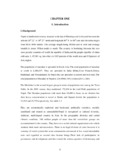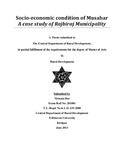Please use this identifier to cite or link to this item:
https://elibrary.tucl.edu.np/handle/123456789/2256| Title: | Socio-economic condition of Musahar a case study of Rajbiraj Municipality |
| Authors: | Deo, Nirmala |
| Keywords: | Socio economic;Study;Rural development |
| Issue Date: | 2019 |
| Publisher: | Central Department of Rural Development |
| Abstract: | The aim of this study is to give a description of Musahar community, a socially dominated and backward caste group of Nepal.The study focuses on the socio-economic condition of Musahar community in Rajbiraj Municipality, Saptari district. The data collection instruments are observation, structured interview schedule, household survey and interview with key informants. The data are analyzed by descriptive method and presented in table, chart, diagram and percentage. Thirtyrespondents were taken purposively. It is believed that their name is derived from the word Musa (rat). It is said that they have migrated in Nepal 700 years agofrom southern neighborcountry India. However, there is no concrete evidence to corroborate the fact that these people actually migrated centuries ago and settled down four centuries ago. A total of 30 household were surveyed through pre-structured questionnaire through random sampling. The life expectancy of the Musahar population is low in comparison to the national data. There were only four respondent of age more than 60 years. Gender discrimination is prominent in the study population. Female members were reluctant to interact with us. We had only two female respondents. Most of the Musahar family had more than two children. It may be due to the lack of awareness and to look for the male child.Of the thirty household twenty five had nuclear family. This shows the change in earlier trend where joint or extended family was more existent. Land is important natural resources for Musahar. But the Musahars are mostly landless and they are earning their living bread and butter by working as labourer either as agriculture labour or any other sector. They don't possess any cultivable land of their own. They usually work for rich persons on daily wage basis of Nepal.Literacy rate among the Dalits is as low as 10.7% whereas at the national level literacy rate is over 50%. In certain Dalit communities such as among Musahars the literacy rate is 4% till today. Literacy rate among the Dalit women is as low as3.2%. The Dalit children find it difficult to receive education in the schools partly due to the social discrimination and partly for their inability to pay for tuition fee and textbooks.Most of the Musahar people of the study area are settled in huts (sixty%) and forty% live in huts with tiled roof. They have ‘taati’(walls made of bamboo sticks) are after plastered with mud. The earthen floor is at times cleaned with thin coat mud and cow dung in most cases Of the thirty respondent twenty eight had received Citizenship. Two of the female respondent didn’t have citizenship card. They are victims of racial and social discrimination. They live in aterrible plight both socially and economically. They have no access to any natural resources, technological knowledge and educational opportunities. They don’t have land for cultivation and their social lives are quite miserable and low. Agricultural labour is the main occupation. The government needs to formulate special programs and policies for these people. Income generating and skill generating programs shall be useful for the economic upliftment of this community. Basic health education, adult literacy programs should be introduced to raise their awareness. |
| URI: | http://elibrary.tucl.edu.np/handle/123456789/2256 |
| Appears in Collections: | Rural Development |
Files in This Item:
| File | Description | Size | Format | |
|---|---|---|---|---|
| Chapter Page (4).pdf | 1.71 MB | Adobe PDF |  View/Open | |
| Cover Page(5).pdf | 54.59 kB | Adobe PDF |  View/Open |
Items in DSpace are protected by copyright, with all rights reserved, unless otherwise indicated.
